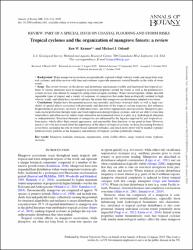| Author | Krauss, Ken W. | |
| Author | Osland, Michael J. | |
| Accessioned date | 2024-01-07T19:37:50Z | |
| Available date | 2024-01-07T19:37:50Z | |
| Year | 2020 | |
| Citation | Krauss, K. W., & Osland, M. J. (2020). Tropical cyclones and the organization of mangrove forests: a review. Annals of Botany, 125(2), 213-234. Recuperado de: | es |
| URI | https://bvearmb.do/handle/123456789/3850 | |
| Abstract | Background: Many mangrove ecosystems are periodically exposed to high velocity winds and surge from tropical cyclones, and often recover with time and continue to provide numerous societal benefits in the wake of storm events. Scope: This review focuses on the drivers and disturbance mechanisms (visible and functional) that tropical cyclones of various intensities have on mangrove ecosystem properties around the world, as well as the potential ecosystem services role offered by mangroves along storm-ravaged coastlines. When viewed together, studies describe repeatable types of impact and a variety of responses of mangroves that make them ecologically resilient to high velocity winds, and which have served to advance the notion that mangroves are disturbance-adapted ecosystems. Conclusions: Studies have documented massive tree mortality and forest structural shifts as well as high variability of spatial effects associated with proximity and direction of the tropical cyclone trajectory that influence biogeochemical processes, recovery of individual trees, and forest regeneration and succession. Mangroves provide coastal protection through surge and wind suppression during tropical cyclones, and yet are able to overcome wind effects and often recover unless some alternative environmental stress is at play (e.g. hydrological alteration or sedimentation). Structural elements of mangroves are influenced by the legacies imposed by past tropical cyclone injury, which affect their current appearance, and presumably their function, at any point in time. However, much is yet to be discovered about the importance of the effects of tropical cyclones on these fascinating botanical ecosystems, including the role of storm-based sediment subsidies, and much more effort will be needed to predict future recovery patterns as the frequency and intensity of tropical cyclones potentially change. | es |
| Language | English | es |
| Published | Annals of Botany, 125(2), 213-234 | es |
| Rights | Published by Oxford University Press on behalf of the Annals of Botany Company 2019. Public domain. | es |
| Subject | Recursos naturales | es |
| Subject | Recursos costeros y marinos | es |
| Subject | Clima | es |
| Subject | Desastres naturales | es |
| Subject | Impacto ambiental | es |
| Title | Tropical cyclones and the organization of mangrove forests : a review | es |
| dc.identifier.doi | https://doi.org/10.1093/aob/mcz161 | |
| Material type | Article | es |
| Type of content | Scientific research | es |
| Access | Open | es |
| Audience | Technicians, professionals and scientists | es |


